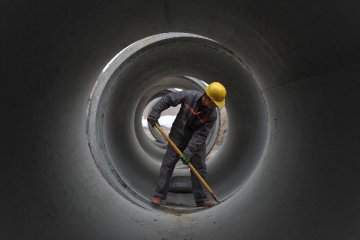
During the “13th Five-year Plan” period, SOEs reform will become new impetus for economic development. Following the launch of top level design for SOEs reform, ten relevant documents are expected to be issued in the near future.
Important policies successively issued
Responsible person from the State-owned Assets Supervision and Administration Commission (SASAC) of the State Council indicated recently that SASAC has issued nine supportive documents so far, and another ten documents are to be unveiled soon. On the basis of reforms on various aspects carried out by SASAC last year, the State Council Leading Group Office on SOE reform has researched and identified ten pilots , including merging and reorganization pilot of central SOEs, mixed ownership reform pilot in important fields, employee stock ownership pilot of mixed ownership enterprises, and the pilot of investment and operation company of state-owned capital. The ten pilots will be unfolded next year. Meanwhile, local and central SOEs are encouraged to actively conduct pilot works in different forms according to realities. Once all capital stocks of the 107 central SOEs and 39,000 enterprises are activated, merging and reorganization of central SOEs on group level and industrial level will be greatly pushed forward.
Lian Weiliang, vice minister of the National Development and Reform Commission (NDRC) said that reform of SOEs and key industries will be deeply implemented. Important industries like electricity, oil and gas, railway, civil aviation, telecommunication and military industry have all conducted pilot works for mixed ownership reform, marking the fully opening of competitive sectors represented by electricity and petroleum.
Besides, recent executive meeting of the State Council clearly pointed out that enterprises which suffer losses for more than three consecutive years and go against the direction of restructuring should be liquidated by means of assets restructuring, property transferring, closedown, and bankruptcy. And those “zombie enterprises” should also be cleaned up. The goal is to significantly reduce losses of unprofitable operational enterprises by the end of 2017.
“From the key points of reform underscored by the regulators, the current tasks of defusing excessive productive capacity and promoting industrial optimization and reorganization are important to the progress of supply side reform. The forthcoming Central Economic Working Conference may make arrangement to promote supply side reform and clean up ‘zombie enterprises’ in 2016,” said Li Jin, vice chairman of China Enterprise Reform and Development Society.
“As to mixed ownership reform, relevant supervisory rules concerning transfer of state-owned property rights for enterprises should be formulated, revised and improved, to establish internal and external monitoring mechanism with high efficiency and synergy,” said Chen Qingtai, a former vice-minister of the State Council Development Research Center, adding that there’s not much enthusiasm for mixed ownership reform at present, primarily due to systematic obstacles existed in the development of mixed ownership, namely, the relationships between the ownership and management power, and the government and enterprises, are not clearly classified.
Li Shuguang, head of bankruptcy law and enterprise reorganization research center of China University of Political Science and Law, believed that 2016 is a crucial year for the implementation of reform. On both national and local levels, categorized reform, mixed ownership, alliance between giants, overall listing, improvement of assets securitization ratio will all expected to make breakthroughs. Currently, SOE reform is gradually moving forward, as reform pilots will be further expanded, and central enterprises’ merging and reorganization led by SASAC is accelerating. It is expected that merging, reorganization and securitization of central enterprises will see upsurge in the coming year.
Merging and reorganization of central enterprises heat up
With the introduction of top level design, central enterprises reform further speeds up. Entering December, three reorganization cases took place within about ten days. On Dec.1, SASAC announced that the reorganization between Nam Kwong (Group) Co., Ltd. and Zhuhai Zhen Rong Company. Zhuhai Zhen Rong Company will be merged into Nam Kwong (Group) Co., Ltd. and become a subsidiary of the latter in mainland China. On Dec.8, China Metallurgical Group Corporation and China Minmetals Group announced to conduct strategic reorganization, and China Metallurgical Group Corporation will integrated into China Minmetals Group, becoming a wholly owned subsidiary of the latter. On Dec.11, two shipping giants, China Ocean Shipping (Group) Company (COSCO) and China Shipping Group Company, announced to implement reorganization.
Moreover, the market frequently spreads out the merging rumors on China Merchants Group and Sinotrans & CSC Holdings Co., Ltd., China United Network Communications Limited (CHU.NYSE; 00762.HK; 600050.SH) and China Telecom Corporation Ltd. (CHA.NYSE; 00728.HK), China Railway Group Limited (00390.HK; 601390.SH) and China Railway Construction Corporation Limited (01186.HK; 601186.SH), China State Shipbuilding Corporation and China Shipbuilding Industry Corporation, Baosteel Group Corporation and Wuhan Iron and Steel (Group) Corp., the three largest airlines, as well as cargo airlines. Although related companies repeatedly deny such rumors, listed companies’ constant suspensions in the secondary market still arouse the speculation of the market.
Li Shuguang believes that merging, acquisition & restructuring of the central SOEs can realize various goals: in terms of overseas markets, these measures can support the “the Belt & Road Initiative” and form a comprehensive industrial chain to meet the enterprises’ demands for “going out” to involve in the international competitiveness; for China, they can mainly defuse the surplus capacities, improve the achievements of such enterprises, and solve the problems left over in the history. Additionally, merging and restructuring can also prepare the work for mixed ownership reform, establishment of investment & operation companies, asset securitization and etc. Strength will be intensified for merging, acquisition & restricting in 2016, which now focuses on Commerce Category I. Merging, acquisition & restricting for Commerce Category II and public benefit types are much complicated and difficult in the following reforms.
Huang Qunhui, head of Institute of Industrial Economics of CASS, believes that merging, acquisition & restricting are major measures to implement the strategic adjustment on state-owned economy. Through these measures, central SOEs have reduced to a number of 107 now. It is reported that State-owned Assets Supervision and Administration Commission (SASAC) once proposed a reform goal of reducing the number of central SOEs to a range of 30 to 50. This goal meets the actual requirement on effective operation and supervision of central SOEs under the new and normal status in the future, and merging, acquisition & restricting of the central SOEs should be positively promoted. Based on current situation, these 107 central SOEs will be the cores during the SOE reform with merging & restructuring and asset securitization as the highlights.
Upgrading of local SOE reform
Along with the successively-held local “two sessions”, a new round of local SOE reform is incubated for upgrading. Based on issued reform schemes, provinces and cities with a faster reform step, including Shanghai, Guangdong Province and Shandong Province, are actively formulating the detailed schemes related to the reform, and local SOE reform enters into a period of full acceleration. In terms of reform direction, restructuring, mixed ownership reform, asset securitization, listing, employee shareholding plan and etc. have become the key targets. Some regions issued the goals on asset securitization ratio for next five years: 50 percent for Beijing and Hubei Province, 60 percent for Jiangxi Province and Henan Province, 80 percent for Chongqing City and Hunan Province, and 70 percent for Guangdong Province.
Recently, Guangdong SASAC proposed that it should continue to promote the restructuring and establishment of pilot companies for investment and operation on state-owned capital, and speed up the pilot work on reform and innovation of system and mechanism for 50 enterprises, so that it may realize the asset securitization ratio of 70 percent for its enterprises by 2020 after deducting the expressways and railways of the public features, and main businesses of competitive enterprises could basically realize the overall listing.
Jilin Province recently proposed that it will focus on the SOE reform during the period of “13 Five-year Plan”, and enhance the adjustments in deployment and structure of state-owned economy. Jilin Province will carry out the reform on authorized operation system of state-owned capital, and it will also restructure and establish the investment & operation companies for state-owned capital through various methods, such as transfer, merging, separation and restructuring.
Huatai Securities (601688.SH) points out that there are 971 central and local SOEs listed in the A-share market, with a total market value of 27.44 trillion yuan. In terms of moves on SOE reform taken by major provinces and cities, including Shanghai, Zhejiang Province and Jiangsu Province, local SOE reform covers three major measures: 1) to focus on improving securitization ratio of state-owned assets, such as injecting platform of listed companies into the assets of groups, realizing overall listing through the listing platform under the assets of groups, realizing partial or overall listing of non-SOEs through backdoor listing, as well as IPO; 2) to highlight mixed ownership system, such as attracting diversified investors through private placement, senior management and employee shareholding plan, and etc.; 3) to rely on operation and integration of state-owned capital, such as building investment and operation companies for state-owned capital, promoting merging & restructuring of state-owned capital, and transferring such capital into social security funds for unified operation. Substantial moves for the reform, including asset injection, are likely to attract the market players. Currently, asset securitization ratios of provincial enterprises commonly range from 20 percent to 40 percent, and there is a huge space for the assets of the enterprise groups under local counterparts of SASAC to be gradually injected into the listed companies.
Translated by Jelly Yi and Adam Zhang




















Latest comments